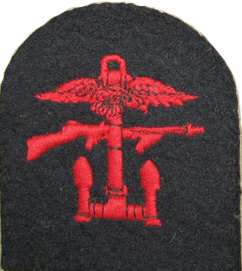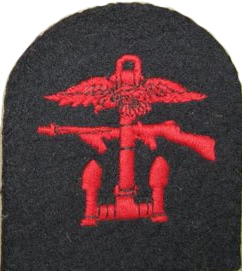The Belgian Commando's


| Home | Creation | Organization | Campaigns | Names | In Memoriam | Monuments | Testimonies | Federation | Links | fr | nl |
|---|
The Belgian Commando's
|
||
|---|---|---|
 |
Names of the Commandos |  |
| Fallen to the Field of Honour |
Created in 1942, under command of captain G. DANLOY, the "4th Troop of the Nr 10 Inter-Allied Commando" (10 I.A.Cdo) (Troop means a commando company. It includes approximately 100 men with two assault sections and a staff) follows for more than a year, a hard training in England, specialized in amphibians operations and raids.
In December 1943, the "green berets" are on fight at Sangro (Italy) with the 8th British Army. They are the first Belgian soldiers of the Ground Force to take again the combat in Europe (attacks of Petrilli). Then they are in fight on the "Gustav line" (Garigliano, attacks of mounts Ornito and Failto). On March, 1944 they are on "Vis Island" (Yugoslavia), make operations on the Dalmates islands occupied by the Germans, and attack German's convoys of supply. At the request of the Belgian government in London, the Belgian commandos come back in England at the beginning of June 1944.
After a reinforcement (their losses, a dozen killed and wounded, were replaced), on August they will go for a reconnaissance mission on "Yeu Island" (Vendée, France) and will have, a little later, again the occasion to be distinguished while taking part in the operation INFATUATE. on the "Walcheren Island" (Netherlands).
After the liberation of France and Belgium, the Germans reinforced their positions on "Walcheren Island" in order to stop the access to the heaven of Antwerpen of the American and British ships.
Walcheren must fall. But the "Market-Garden" operation in Arnheim last and on October 9, 1944 the operation is decided. The Commander of the 1st Canadian Army is in charge to manage the operation. There are three phases :
- isolate the "Zuid-Beveland" peninsula
- take Zuid-Beveland by a double operation, one on ground, the other by amphibious starting from Terneuzen
- make fall Walcheren by triple attack from the south, the East and the West. It's in preparation for this third phase, baptized INFATUATE that the 4th Commando Brigade (which formed by part of the Belgian Commandos).
The Island was transformed into a true fortress with many powerful obstacles and weapons. The most defences spread on the Western coast between Domburg and Vlissingen.
During October, the defenders have to undergo violent bombardments by the RAF. Some dams are broken, the centre of the Island is flooded, but the batteries continue to shoot.
The operation against Vlissingen, INFATUATE I, is entrusted to the 155th Brigade of the 52nd British Division reinforced by the 4th Commando, composed of British and two French Troops.
The commando units leave Breskens on November, 1 at 04.30, by landing ships. Under the support of an artillery preparation, the men of the 4th Commando unload and establish quickly a head of bridge. There are heavy combats in the flooded streets and the houses in ruins.
The first elements of 4th King's Own Scottish Borderers (KOSB) unload at 07.30 Hr. The Scottish's penetrate in the city and enlarge the head of bridge. They fight all the day.
The 5th KOSB has some difficulties, because of the shootings of violent artillery shoots from Walcheren, but manages to unload at 17 hours.
All its units will fight up to 3 hours in the morning... At this time, Vlissingen is practically in the hands of the Allies. The 4th Commando moves then towards the West in direction of the 4th British Brigade Commando which fights around Westkapelle.
During the last days of October, the 4th Troop is maintained in a camp close De Haan (Belgian Coast) surrounded by barbed wires and firmly kept to receive their secret instructions and to prepare their mission. The 4th Brigade Commando with the Belgians and Norwegians of the 10 I.A. Cdo, the 41th, 47th and 48th Royal Navy Commando (R.M. Cdo) and reinforced by a squadron of 24 armoured vehicles of the 79th Division are preparing the mission "INFATUATE II".
On October, 31, 130 units leave the heaven of Ostende in direction to Westkapelle. The RAF can't take off. It stays in England consequently of fog.
The 41 R.M. Cdo and both Troops of the 10 I.A. Cdo unload. The Landing Craft Tank which transported the Belgians was touched. Captain DANLOY gives the order to unload earlier. The veterans throw themselves in the cold water towards the dams, carrying their weapons, ammunition and radios above their head.
The 41 R.M. Cdo and both Troops take hold quickly of Westkapelle. In the afternoon, supported by the Belgians and the Norwegians installed in base of fire, the 41th R.M. attacks the enemy battery of artillery. It wins.
November 2, both commando's units spring towards the North to conquer a German battery and attack the village of Domburg. The 47th R.M. Cdo passes in reserve. The 10 I.A. Cdo succeeds and establishes a position through the partially conquered village. The following day, with the support of two tanks, the advance begins again and the enemy is dislodged. But in the north of Domburg the situation stays difficult. Others German batteries continue to shot. The strip of land who conducts from Domburg to the battery is ideal for the defence : on the left dunes and the sea, on the right, hug the dunes and overhang the flood. The both great units progress on front : the 41th R.M. Cdo in the dunes, the 10 I.A. Cdo in the wooded line. In this half-flooded area, stuffed traps and where fall enemy mortar shells, the progression is very slow.
On 5th of November 1944, the effective of the 4th Troop is 62 men. Whereas their leader was going to give them a few hours of rest, it receives the order to send a section to occupy an advanced position in the North of Domburg. The following day, this section is joined by all the Troop. On the afternoon the order is given to pass on the attack. Lieutenant MENY and his men, who spent the night to the outposts under a beating rain, progress on the left, the lieutenant ROMAN on the right. The German outposts fall under the dash from the Belgians, who in a few tens of minutes reach the position. Soon, more than 100 Germans are made prisoners.
On left, the A-section stays on the ground by enemy shootings. Its leader, lieutenant MENY, tries to release it. He falls suddenly, reached a bullet in the chest. First sergeant ARTEMIEFF takes the command he is wounded and is replaced by sergeant DELEENER. The section still does not manage to escape. The Commando DIVE also falls, mortally wounded. Captain DANLOY, judging the gravity of the situation, orders to the B-section, commanded by lieutenant ROMAN to attack by the sides: one by one the enemy positions are conquered. It's the victory, the position is completely invested.
On the morning of November 8, the positions and defences of Vrouwenpolder are conquered by the Franco-English commandos and the junction carried out with the Belgians. Walcheren was, without question the hardest campaign conducted by the "Green Berets". Their sacrifices, their losses (22 killed and wounded) won't be useless because on November 4, 1944, three minesweepers already could go up the "Escaut River". Then, a hundred minesweepers will drive out mines without slackening during 24 days and on November 28, three supply ships reach the heaven of "ANTWERPEN".
Re-entered to Great Britain after Walcheren, the " 4th Troop " will officer the new volunteers of Autumn 1944 at the commando camp at Achnacarry (Scotland) where they win their green beret. They form three " Troops ": 4th, 9th, 10th and a staff commanded by George DANLOY appointed major.
Beginning April our commandos join the village of Emsdetten in Germany. They are attached to the "1st Commando Brigade". They go towards the Baltic not without receiving the rendering of several German units and meeting the first survivors of the camps of deportation.
On May 5, the Belgian troops arrive to Lubbeck, then reach the Baltic where they release political prisoners.
May 9, it's the end of the hostilities.
The Green Berets, after having operated in Italy, Yugoslavia, France, the Netherlands and in Germany will re-enter, first in Leopoldsburg, to escort Belgian SS of which they had the guard, for then join Marche-les-Dames and Namur where they will form the "Regiment Commando".